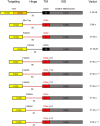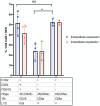Extracellular domain, hinge, and transmembrane determinants affecting surface CD4 expression of a novel anti-HIV chimeric antigen receptor (CAR) construct
- PMID: 39133676
- PMCID: PMC11318886
- DOI: 10.1371/journal.pone.0293990
Extracellular domain, hinge, and transmembrane determinants affecting surface CD4 expression of a novel anti-HIV chimeric antigen receptor (CAR) construct
Abstract
Chimeric antigen receptor (CAR)-T cells have demonstrated clinical potential, but current receptors still need improvements to be successful against chronic HIV infection. In this study, we address some requirements of CAR motifs for strong surface expression of a novel anti-HIV CAR by evaluating important elements in the extracellular, hinge, and transmembrane (TM) domains. When combining a truncated CD4 extracellular domain and CD8α hinge/TM, the novel CAR did not express extracellularly but was detectable intracellularly. By shortening the CD8α hinge, CD4-CAR surface expression was partially recovered and addition of the LYC motif at the end of the CD8α TM fully recovered both intracellular and extracellular CAR expression. Mutation of LYC to TTA or TTC showed severe abrogation of CAR expression by flow cytometry and confocal microscopy. Additionally, we determined that CD4-CAR surface expression could be maximized by the removal of FQKAS motif at the junction of the extracellular domain and the hinge region. CD4-CAR surface expression also resulted in cytotoxic CAR T cell killing of HIV Env+ target cells. In this study, we identified elements that are crucial for optimal CAR surface expression, highlighting the need for structural analysis studies to establish fundamental guidelines of CAR designs.
Copyright: © 2024 Zenere et al. This is an open access article distributed under the terms of the Creative Commons Attribution License, which permits unrestricted use, distribution, and reproduction in any medium, provided the original author and source are credited.
Conflict of interest statement
The authors report no conflict of interest that may arise from this research.
Figures







Update of
-
Extracellular domain, hinge, and transmembrane determinants affecting surface CD4 expression of a novel anti-HIV chimeric antigen receptor (CAR) construct.bioRxiv [Preprint]. 2023 Oct 26:2023.10.25.563930. doi: 10.1101/2023.10.25.563930. bioRxiv. 2023. Update in: PLoS One. 2024 Aug 12;19(8):e0293990. doi: 10.1371/journal.pone.0293990. PMID: 37961145 Free PMC article. Updated. Preprint.
Similar articles
-
Extracellular domain, hinge, and transmembrane determinants affecting surface CD4 expression of a novel anti-HIV chimeric antigen receptor (CAR) construct.bioRxiv [Preprint]. 2023 Oct 26:2023.10.25.563930. doi: 10.1101/2023.10.25.563930. bioRxiv. 2023. Update in: PLoS One. 2024 Aug 12;19(8):e0293990. doi: 10.1371/journal.pone.0293990. PMID: 37961145 Free PMC article. Updated. Preprint.
-
Chimeric antigen receptor (CAR) T-cell therapy for people with relapsed or refractory diffuse large B-cell lymphoma.Cochrane Database Syst Rev. 2021 Sep 13;9(9):CD013365. doi: 10.1002/14651858.CD013365.pub2. Cochrane Database Syst Rev. 2021. PMID: 34515338 Free PMC article.
-
A new sort of cells for chimeric antigen receptor T-cell therapies-isolating CD14-CD127+ T cells for chimeric antigen receptor T-cell manufacture.Cytotherapy. 2025 Aug;27(8):980-990. doi: 10.1016/j.jcyt.2025.04.068. Epub 2025 Apr 18. Cytotherapy. 2025. PMID: 40380956
-
Membrane-bound IL-7 immobilized by the CD8 transmembrane region improves efficacy of CD19 CAR-T cell therapy.Mol Cancer. 2024 Oct 23;23(1):236. doi: 10.1186/s12943-024-02154-0. Mol Cancer. 2024. PMID: 39443955 Free PMC article.
-
Recent advances on anti-HIV chimeric antigen receptor-T-cell treatment to provide sustained HIV remission.Curr Opin HIV AIDS. 2024 Jul 1;19(4):169-178. doi: 10.1097/COH.0000000000000858. Epub 2024 May 1. Curr Opin HIV AIDS. 2024. PMID: 38695148 Free PMC article. Review.
Cited by
-
Chimeric antigen receptor therapies: Development, design, and implementation.J Allergy Clin Immunol. 2025 Jul;156(1):70-80. doi: 10.1016/j.jaci.2025.04.005. Epub 2025 Apr 10. J Allergy Clin Immunol. 2025. PMID: 40220909 Review.
References
MeSH terms
Substances
Grants and funding
LinkOut - more resources
Full Text Sources
Research Materials

